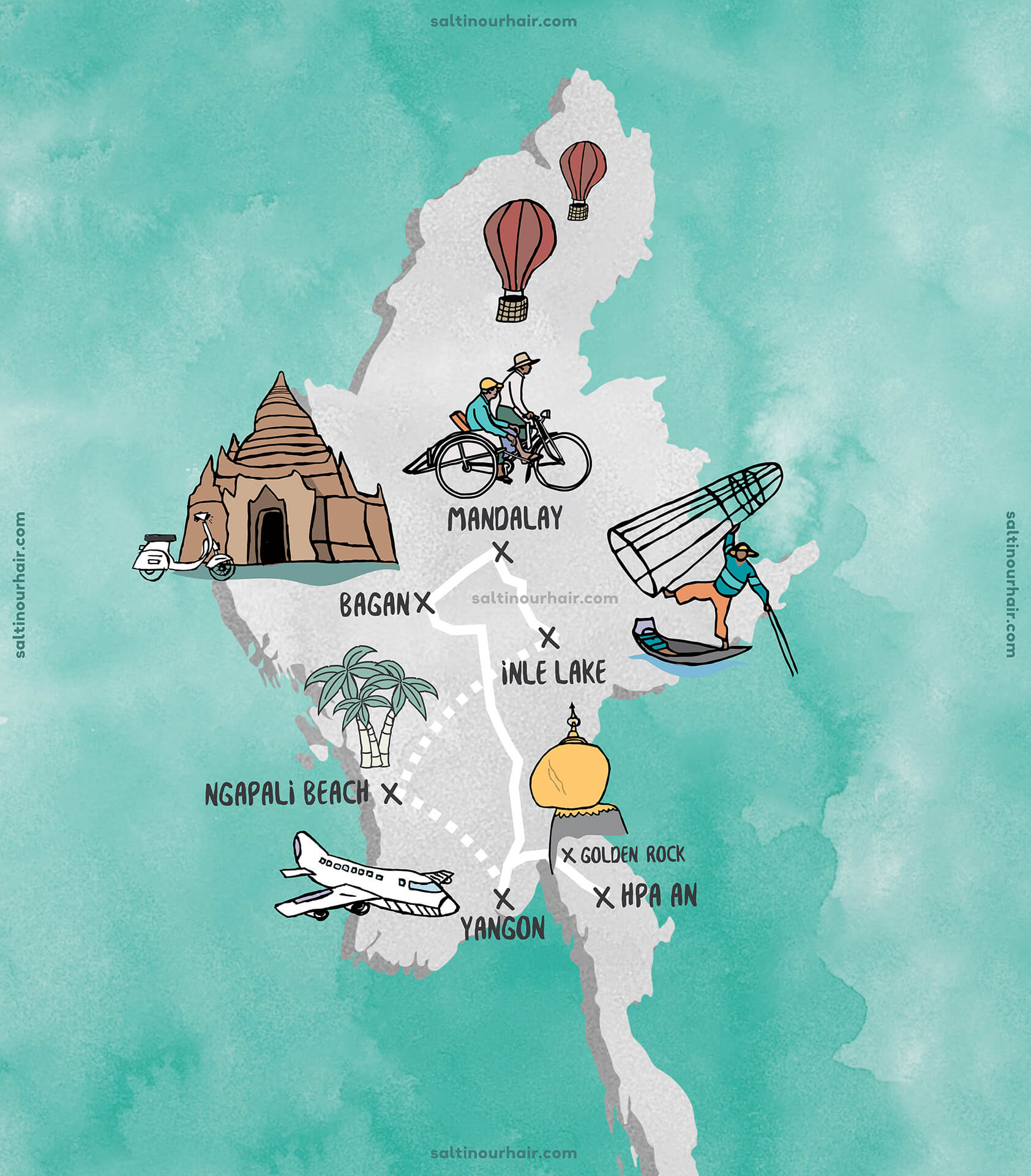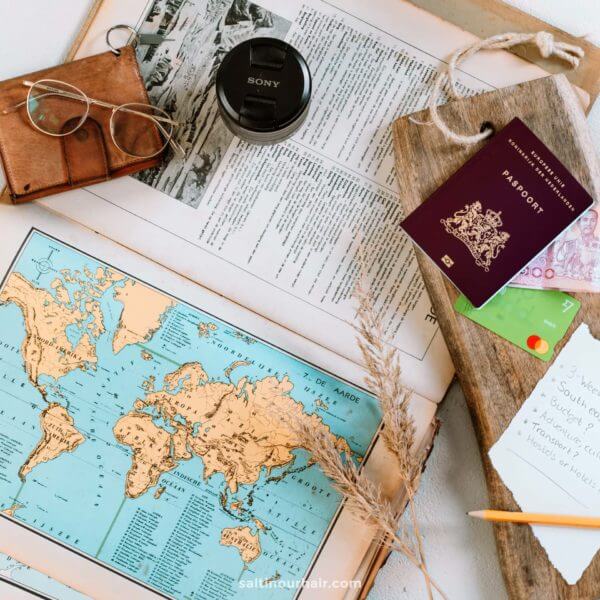Best time to visit Myanmar
Travel Insurancefor Myanmar
Best places to visit in Myanmar

Map of Myanmar
Weather in Myanmar
Myanmar has a sub-tropical monsoon climate with warm temperatures. The hot season (Feb-May) is very warm, with an average of 32°C. The rainy season is split per region: rainy southwest monsoon (May-Oct) and relatively dry northeast monsoon (Oct-Feb).
- Find Hotels via Booking.com
- Find Hostels via Hostelworld
- Find a Rental Car via Sunny Cars
- Find Cheap Flights via Skyscanner
- Get a Travel Insurance via Heymondo
- Book Tours & Attractions via Viator
- Book a Bus/Train/Transfer via 12Go
- Get a Visa via iVisa
- How to pack light for your trip
- How to plan your trip our tips
Myanmar, or Burma, is a must-visit destination for those looking for incredible scenery. Chockfull of incredible nature, such as mountains, waterfalls, rice fields, and white beaches, comes beautifully together with thousands of Buddhist temples dotted around the country.
Overall, Myanmar is a cheap place to visit. However, accommodation costs can run up quickly, more than in other Southeast Asian countries. Expect to spend about $50 a day, including budget accommodation and restaurants.
Unfortunately, tap water isn’t safe to drink in Myanmar, especially for tourists. Because of this, stick to purified water that you can get from most stores and supermarkets. For a better, eco-friendly option, bring a reusable water bottle with a built-in filter system or fill up at restaurants with filtered water.
To enter Myanmar (Burma), you need a valid passport with at least six months of validity and a valid visa. This visa allows you to travel as a tourist for 28 days and must be arranged before entering the country. You can do this at a Burmese consulate or apply online for an eVisa.
The official language in Myanmar is Burmese. During colonial times, English became the official language. Still, Burmese continued as the primary language in all other settings, spoken by the people of the plains and in the hills (as a second language).
Travel insurance is your safety net for all your travels, allowing you to enjoy your holiday in Myanmar with peace of mind. From unexpected medical expenses to lost luggage, it ensures a worry-free trip. Note: Foreign travelers must present printed proof of travel insurance covering COVID-19 on arrival in Myanmar.
While Myanmar is generally safe for tourists, it’s important to remember that the country currently has ongoing political conflicts with regular protests, civil unrest, and sometimes violence. Because of this, exercise caution when traveling in Myanmar.
Myanmar has five different plug types: types A, C, D, G, and I. Plug Type A has two flat parallel pins, C has two round pins, and D has three round pins in a triangle pattern. Stay connected by bringing an adapter to plug into the electricity.
Myanmar is a country full of fascinating history, culture, and nature, turning it into a more popular destination. Full of ancient temples, pagodas, wild deserts, and a new society, it’s opening itself up to the world despite its struggles.
Travel in Myanmar
As the largest country in Southeast Asia, Myanmar remains one of the least visited in the region. With its many beautiful golden temples dotted across the lush countryside, it’s often referred to as the Golden Land, offering a peaceful travel destination. Travel past the bustling city of Yangon, visiting Inle Lake, and heading into the misty mountains after. From beaches to thousands of Buddhist temples, those are only some of the best places in Myanmar worth a visit.
How to Plan Your Trip to Myanmar
Use our Myanmar travel guides to plan the perfect trip! Explore lush rice paddies and powerful rivers in hidden gems like Hpa An. Or, visit one of the many stunning temples in Bagan, admiring all the different pagodas and one of the best things to do in Myanmar.
Check out our complete Myanmar itinerary or browse our informative travel guides.
Best Time to Visit Myanmar
Myanmar has different climate zones that all experience different weather throughout the year. It’s warm, humid, and wet in Myanmar, but temperatures vary per region and season. Due to its coastal location, the country sees two distinct monsoon seasons. However, showers usually happen in the afternoons/evenings, leaving plenty of time for beach bumming and exploring in the mornings.
Hot season (Feb-May): With average temperatures of 32°C, this is the warmest time in Myanmar. Especially on the coast with high humidity, it feels very warm. However, it’s generally a bit cooler in the northern mountains or around areas like Bagan. The warmest and rainiest part of the country is Mandalay, and Kachin is the coldest.
Rainy season (May-Oct): This period sees the most precipitation (about 2,500 – 5,500mm of rain). Especially in coastal areas and southwestern regions around the Ayeyarwady Delta, see the typical Southeast Asia weather, with warm temperatures and more risk of tropical cyclones. The central ‘dry zone’ is more or less protected by mountains and sees less rain.
Cool season (Oct-Feb): This is a relatively cool and dry monsoon season, with about 500mm to 1000mm of rain each year, mostly in the northeastern region. This makes it a good time to visit the beautiful white sand beaches like Ngapali Beach, one of the best places to visit in Myanmar.
Most people visit between November and February, but a visit in the months before or after (green seasons) is also a great time.
Coastlines and Beaches in Myanmar
Myanmar’s coastline, largely undiscovered, is full of pristine beauty. Journey down the Bay of Bengal and stop at Ngapali Beach, a serene jewel with palm-fringed shores and crystal-clear waters. Venture further down, and you’ll reach the untouched Myeik Archipelago, where crystalline emerald waters surround hundreds of secluded islands. This coastal paradise remains a hidden gem with unspoiled beaches and world-class diving locations.
The beaches of Myanmar, with their raw and untouched beauty, are the perfect place to escape to. Whether you’re looking to relax on the white shores of Ngapali or are hoping to go beach-hopping, everything is possible.
Food, Culture, and Religion in Myanmar
Myanmar’s cuisine, culture, and religion all come together in a beautiful collection of traditions. The food and culture will quickly leave you in awe of Myanmar as you travel through the country. Travel here is fulfilling whether you’re backpacking, touring, or with an organized group.
Cuisine: With diverse spices, the Burmese have a very flavorful cuisine. Try popular dishes like ‘mohinga’, a fragrant fish noodle soup, or ‘laphet thoke’, a fermented tea leaf salad that typically brings people together. Meals are a communal experience, so don’t skip joining the locals in their teashops, where they gather for aromatic teas and snacks.
Culture: From the ancient temples of Bagan, where thousands of stupas grace the horizon, to the astonishing gold Shwedagon Pagoda in Yangon, Myanmar’s culture lies in its traditions. Traditional puppetry, dance, and music performances show the country’s artistic heritage. This, together with a warm welcome and smile
Religion: Myanmar embraces religious diversity, but Buddhism, predominantly Theravada, is practiced by the majority. Mandalay’s Mahamuni Pagoda and Bagan’s Ananda Temple are just a few of the revered sites. However, Christianity, Islam, and indigenous faiths are also followed.
Why You Should Travel to Myanmar
Having only opened its borders about 10 years ago, Myanmar is full of mystery and remains somewhat of a hidden gem. As the largest country in Southeast Asia, it’s full of beauty, from the white sand beaches to the jungle-covered mountains and lush paddies dotted with beautiful golden temples.
There are many incredible things to do in Myanmar, whether it’s climbing up to the top of a grand Buddha or lazing on the most beautiful beach in Asia. Visit the astonishing Shwedagon Pagoda and other tranquil spots on your Myanmar itinerary, and experience the kindness of the locals.
Safety and Travel Advice in Myanmar
The locals of Myanmar are some of the friendliest people we’ve ever met, and traveling is usually safe. Nevertheless, it’s always good to stay up-to-date about recent events in the country before your Myanmar vacation. As of right now (2023), the Myanmar military still has forced control of the country (since 2021), causing civil unrest and many (sometimes violent) protests. Travel to Myanmar is, therefore, not currently recommended.
!!! Some areas are under a state of martial law, and others, like Yangon, have curfews or stay-at-home orders. If you do travel to Myanmar, ensure you’re always aware of local rules and restrictions. Visitors should be extra vigilant and avoid all demonstrations/political gatherings.
Natural disasters: There are very few natural disasters in Myanmar, though the rainy season (May-Oct) does coincide with the typhoon season in Southeast Asia. During this time, mountains are more susceptible to landslides and rivers to flooding. Register your trip with the embassy to receive emergency updates during your Myanmar travels.
Crime and safety in Myanmar: Besides the current political conflicts, Myanmar is generally safe. Petty crime like pickpocketing or purse-snatching does occur, but there are no accurate records of violent robberies. Take care of your belongings by carrying them securely with you, and avoid isolated areas, especially at night.
There have also been reports of scams involving gems and jewelry where merchants sell lower-quality items at inflated prices. Don’t buy gems or minerals from an unlicensed source.
Learn more about travel safety
Landmines: Due to Myanmar’s turbulent past and present, the threat of landmines in rural areas is high, especially close to the borders. Some areas are marked with signs, but that’s not widespread. Be extremely cautious if you’re traveling off main roads in these particular areas.
Traffic: Road travel in Myanmar can be challenging. Roads and vehicles are often in poor condition, especially during the rainy season when roads and bridges sometimes become impassable. Travel by road outside major cities like Yangon and Mandalay is restricted, and traffic regulations aren’t always enforced. Try traveling only during the day, wear a helmet (often have to buy one), and ensure you have travel insurance.
Outdoor activities: If you’re doing any swimming, boating, or diving on your holiday in Myanmar, always exercise caution and consider your safety. River and sea transport don’t always meet international safety standards, and during the monsoon season, heavy rains can cause flooding. Check with local guides where it’s safe to swim, many beaches have a strong undercurrent and riptides. Only undertake adventure sports with a well-established and reputable company that has insurance.
Travel Insurance: One of the things we always recommend for your trip to Myanmar is getting travel insurance. Whether it’s lost luggage or unforeseen accidents, travel insurance gives you peace of mind. This ensures you have a smoother and worry-free experience.
















